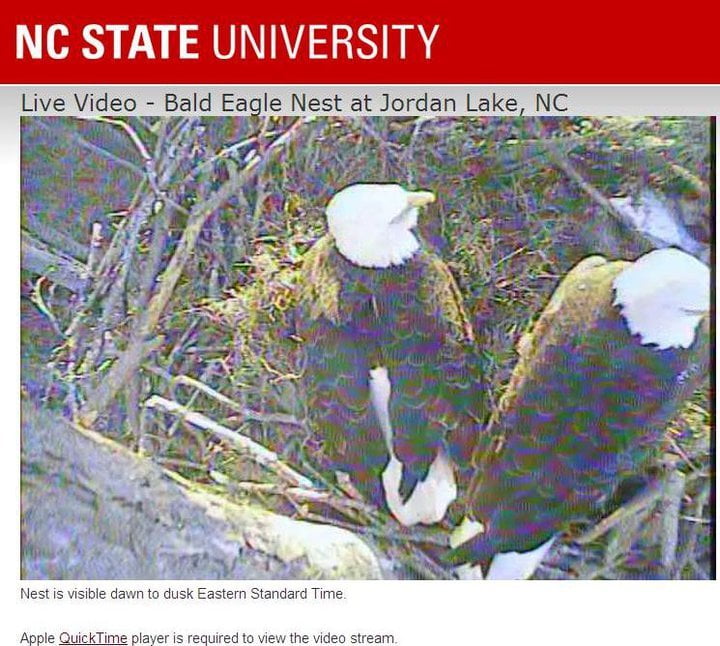Birders are generally well aware of Bald Eagles on our regular outings into eagle country. That’s why it may come as a surprise that few people in the general public – the “normies”, as I like to call them* – realize that Bald Eagles are actually pretty ubiquitous in any body of water of significant size. Much of this likely stems from the days when populations of Eagles and other raptors were ravaged by rampant DDT use and finding a Bald Eagle, let alone an active nest, was a rare treat. For much of the general public this is still the case, despite the fact that the Bald Eagle has rebounded such that it was removed from the Endangered Species list in 2007. It’s quite rightly considered one of the great conservation success stories of the 20th Century, and as it turns out, Bald Eagles are actually quite flexible when it comes to living near people. Jordan Lake, at the southern tier of a region with a population of over a million, hosts no fewer than five active Eagle nests, with several more at Falls Lake to the north of Raleigh. A flashy species located near a lot of people seems to be a no-brainer for some sort of citizen science outreach program.
And lo and behold, there’s one here in North Carolina, organized through North Carolina State University and the Army Corp of Engineers. It consists of a simple camera mounted above a Bald Eagle nests at Jordan Lake. Birders, or any other interested parties, can watch in real time as a pair of Bald Eagles tend to a pair of chicks that hatched no more than two weeks ago. Observers can even help monitor the chick’s growth by emailing the project coordinator or posting on Facebook when the adults bring food or hang out at the nest for any extended period of time or any other interesting or noteworthy behaviors.

This pair of eagles has successfully fledged young for each of the last three years, so odds are good that at least one of the two chicks will get out of the nest. They’re still small now, but it won’t be long before growing chicks will necessitate ever more frequent hunting forays by the two adults, generally the most exciting time to watch these sorts of live feeds.
Fortunately, you’ve got some time before that happens. Bald Eagles take up to three months to go from newly hatched to newly fledged. So for the next several weeks, you can have the privilege of watching these chicks grow until they finally join the rest of the eagle population on Jordan Lake and beyond. An exciting time, indeed!
So go check it out, and don’t forget to help out!
===
*I’ve never actually called them this…. to their faces













I remember watching an interview with Steve Martin on YouTube about the movie “The Big Year” in which Martin recalls seeing a Bald Eagle during a pelagic. He mentioned that this was the first time he’d ever seen an eagle, to which the interviewer exclaimed “Really!!??”
It’s the same thing here in Germany. The white-tailed eagle had been driven to near-extinction during the first half of the 20th century, but now it has become downright common mostly in the east. During my years at the Baltic Sea, I’d often point out soaring white-tailed eagles to tourists from other parts of Germany, and reactions ranged from offended disbelief to almost falling over backwards in amazement.
nice
Funny you should post this, as I was just posting something on my blog (linked in my name above) about catching myself taking bald eagles for granted. We see them everywhere we go in North America, because…well…they ARE everywhere. When I was born (1973) it didn’t look likely there would be any left in 2011. Thank you, Rachel Carson, among others.
@Jochen- I’ve seen that Steve Martin clip as well. I’ve gotten a similar response to pointing out Bald Eagles. I’ve always considered birding to be like a super power in that you notice so much more than regular people do, but it’s doubly so with Bald Eagles since they have such a big place in the popular imagination.
@Edwin- Thanks!
@Kirby- Thank you Rachel Carson indeed. My dad often talks about how some of his most memorable moments as a naturalist in the 60s involved seeing Bald Eagles. It seems so bizarre now, but it goes to show how far they’ve come.
@Nate: it IS a super power(I always enjoy reading the Sherlock Holmes stories for that precise reason: they celebrate the difference between looking and seeing), especially when we apply our observation skills to the other parts of our surroundings .
However, it is a super power that hardly gets any recognition. Which is too bad, really.